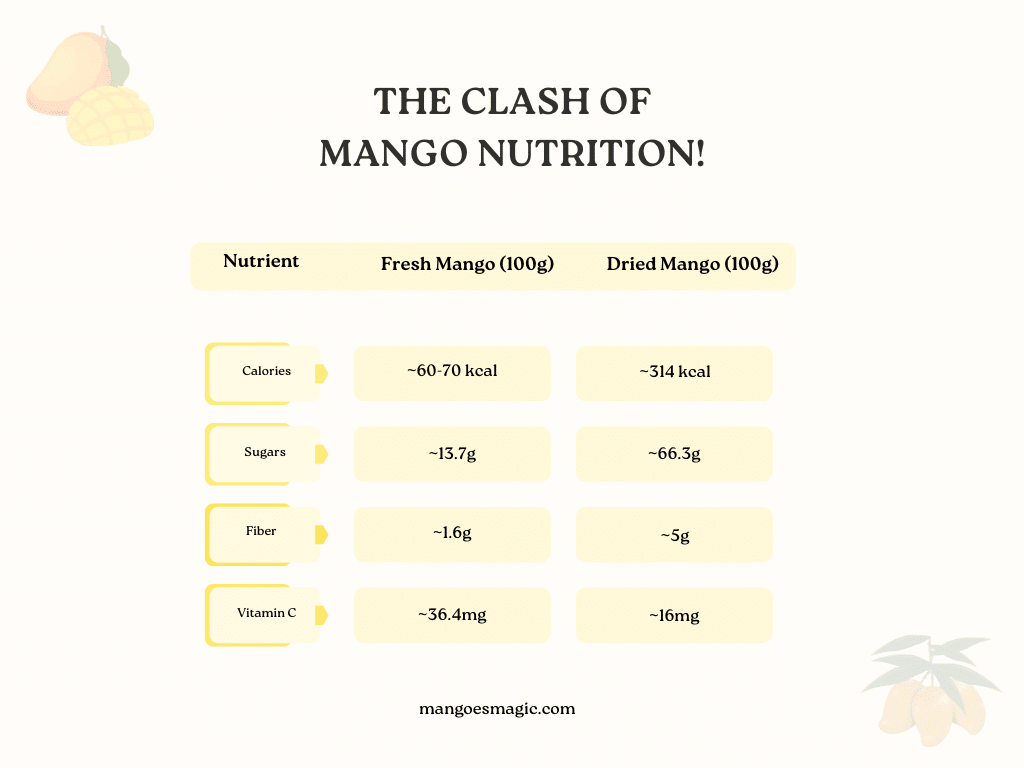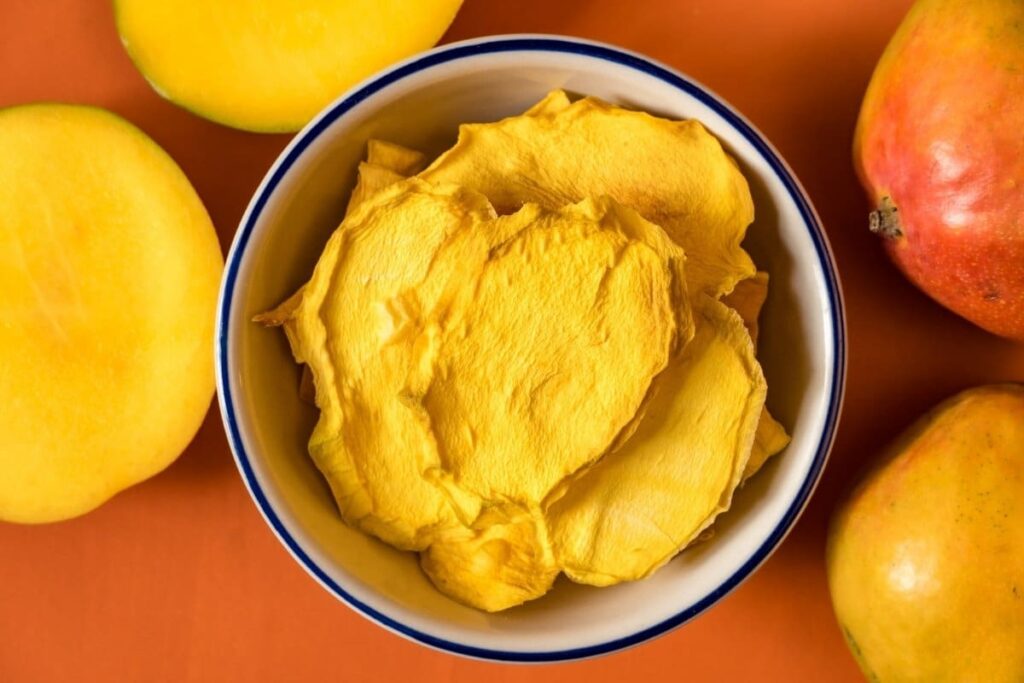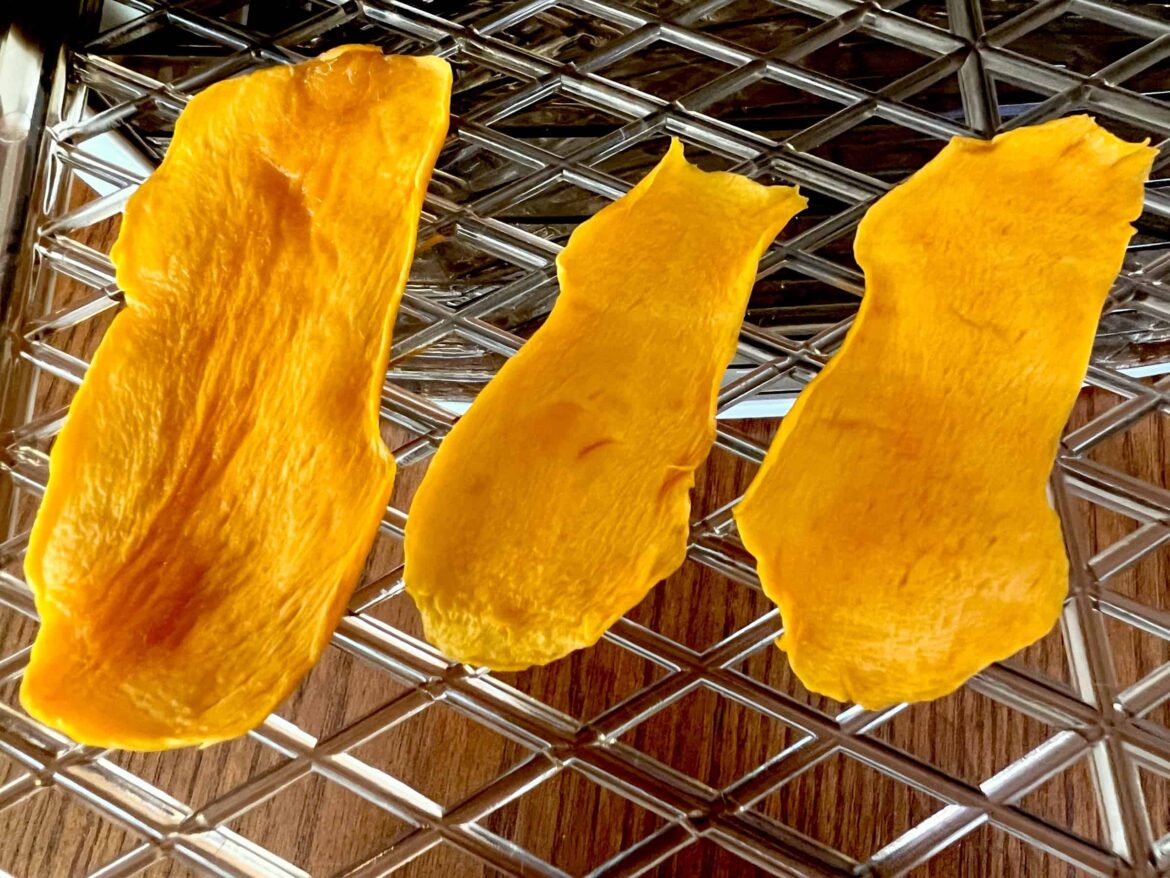Table of Contents
Mangoes are often dubbed the “king of fruits,” and for good reason. Their natural sweetness and tropical flavor make them a favorite among fruit enthusiasts. But what if you could enjoy this delectable fruit year-round? Ah, enter dried mango—a convenient, nutrient-packed snack that brings the sunshine of summer into every bite. Let’s delve into the nutritional value of dried mango and explore why it deserves a spot in your pantry.
Nutritional Breakdown of Dried Mango
Dried mango is a concentrated source of the nutrients found in fresh mangoes. Here’s a closer look at its nutritional profile:
- Calories: Approximately 314 kcal per 100g
- Carbohydrates: 81.61g
- Sugars: 66.3g (natural sugars)
- Dietary Fiber: 5g
- Protein: 1.48g
- Fat: 0.78g
- Potassium: 450mg
- Vitamin C: 16mg (18% of the Daily Value)
- Vitamin A: Present in significant amounts
These values highlight dried mango as a rich source of natural sugars, fiber, and essential vitamins, making it a wholesome snack option when consumed in moderation.
Health Benefits of Dried Mango
Incorporating dried mango into your diet can offer several health benefits:
- Rich in Antioxidants: Dried mango contains antioxidants like mangiferin, which may help protect cells from oxidative stress and reduce inflammation.
- Supports Digestive Health: The dietary fiber in dried mango aids in digestion and promotes a healthy gut
- Provides Essential Nutrients: It offers vitamins A and C, which are vital for immune function and skin health
Considerations When Consuming Dried Mango
While dried mango is nutritious, it’s important to be mindful of certain factors:
- High Sugar Content: The drying process concentrates the sugars, leading to a higher sugar content per serving compared to fresh mangoes.
- Caloric Density: Due to the removal of water, dried mango is calorie-dense, so portion control is key to avoid excessive calorie intake.
- Added Sugars: Some commercially available dried mangoes may contain added sugars or preservatives. Opting for unsweetened and unsulfured varieties can mitigate this concern.
Comparison: Dried Mango vs. Fresh Mango

Understanding the differences between dried and fresh mango can help you make informed dietary choices:
Caloric Content: Fresh Mango vs. Dried Mango
- Fresh Mango: Contains about 60-70 calories per 100g, as it’s mostly water.
- Dried Mango: Has around 314 calories per 100g, as the drying process concentrates the sugars and nutrients.
Key Takeaway: So, if there is a comparison for the nutritional value of dried mango, dried mango is more calorie-dense due to water removal.
Sugar Content: Fresh Mango vs. Dried Mango
- Fresh Mango: A typical serving (one cup) contains around 13.7 grams of natural sugar.
- Dried Mango: If we talk about the nutritional value of dried mango, it packs a punch with 66 grams of sugar per 100g, as the sugar is concentrated in the drying process.
Key Takeaway: Dried mango has significantly more sugar than fresh mango.
Fiber: Fresh Mango vs. Dried Mango
- Fresh Mango: Offers about 3 grams of fiber per medium mango.
- Dried Mango: Provides 5 grams of fiber per 100g, making it a great option for digestive health.
Key Takeaway: Dried mango has more fiber, but portion control is important.
Nutrients: Fresh Mango vs. Dried Mango
- Fresh Mango: Rich in Vitamin C (60 mg per medium mango) and antioxidants.
- Dried Mango: Contains similar nutrients but loses some Vitamin C due to the drying process. However, it still retains Vitamin A and potassium.
Key Takeaway: Fresh mango is better for vitamin C, while dried mango retains other key nutrients.
Portability: Fresh Mango vs. Dried Mango
- Fresh Mango: Heavy and perishable, making it less ideal for on-the-go snacking.
- Dried Mango: Lightweight, shelf-stable, and perfect for carrying around without worrying about spoilage.
Key Takeaway: Dried mango is more convenient for travel and snacking.
As we know now, dried mango is more calorie-dense and has a higher sugar content per 100g compared to its fresh counterpart. However, it also provides more fiber and potassium, making it a nutrient-rich option when consumed in moderation. If you’re curious about the differences between mangoes and other fruits, check out Is Mango a Citrus Fruit? for more insights on the fruit family mango belongs to.
Where to Buy Dried Mango

Credit: freshoffthegrid.com
Dried mango is widely available and can be purchased from various retailers:
- Online Stores: Websites like Amazon offer a range of dried mango products, including organic and unsweetened options.
- Local Grocery Stores: Many supermarkets carry dried mango in their snack or dried fruit sections.
- Specialty Health Stores: Stores focusing on health foods often stock high-quality dried mango without added sugars or preservatives.
When purchasing, check the ingredient list to ensure you’re selecting a product that aligns with your dietary preferences.
Creative Ways to Enjoy Dried Mango
Dried mango isn’t just a snack; it can be incorporated into various dishes:
- Trail Mix: Combine dried mango with nuts and seeds for a balanced, energy-boosting snack.
- Smoothies: Rehydrate dried mango and blend it into smoothies for added sweetness and nutrients.
- Baking: Chop dried mango and add it to muffins, breads, or cookies for a tropical twist.
- Salads: Slice dried mango and sprinkle over salads for a burst of flavor and texture.
The Bottom Line
Dried mango is more than just a sweet treat; it’s a nutrient-packed snack that offers a convenient way to enjoy the benefits of mangoes year-round. While it’s calorie-dense and high in natural sugars, consuming it in moderation can contribute to a healthy diet. Always opt for unsweetened and preservative-free varieties to maximize health benefits.
So, the next time you’re looking for a wholesome snack, consider reaching for some dried mango. Your taste buds—and your body—will thank you!
FAQ’s
Got questions regarding your mango calories? Let’s answer them!
How many calories are in dried mango?
Dried mango contains approximately 314 calories per 100g serving.
Is dried mango high in sugar?
Yes, dried mango is high in natural sugars, with 66.3g of sugar per 100g.
Does dried mango contain fiber?
Yes, dried mango provides about 5g of fiber per 100g serving, supporting digestion.
Is dried mango good for health?
Yes, dried mango offers antioxidants, vitamins A and C, and fiber that promote overall health.
Can dried mango help with weight loss?
In moderation, dried mango can aid weight loss by curbing hunger due to its fiber content, but it’s calorie-dense, so portion control is key.

